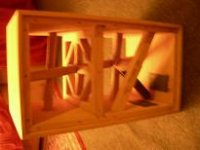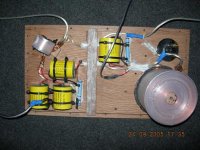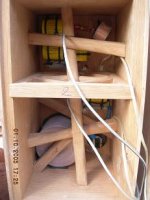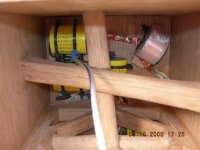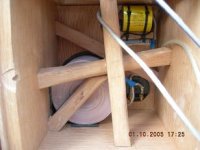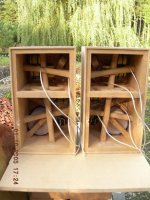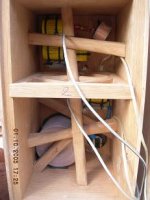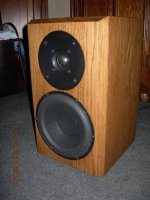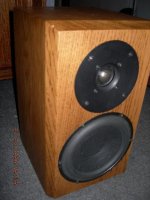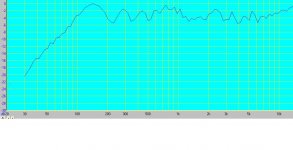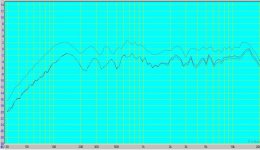I started with my box design at the end of last summer 2005.
I wanted to build a very good box with small dimensions for home use.
My requirements were as follows:
1. Sonics as the primary focus
2. Small dimensions with relatively high power and good bass response for its size.
After searching on the internet I found the studio monitor design of Vance Dickason. This was exactly what I was looking for. Small, sonics as the primary focus, bass as low as 54 Hz at -3dB....
Woofer is SS 18W8545 tweeter D2509/9900 revelator
You can see the design at the following link:
Studio monitor
So I purchased the Speaker design Cookbook of Vance Dickason and started building.
I wanted to use the very best materials. So I've build the box in oak. I've used very expensive caps and coils in my crossover network.
Because I want the best components at no price I've put an air coil in the crossover of the woofer, therefore I must recalculate the net internal volume of the box because Vance didn't use an air coil. The internal volume is exactly 7.9 litre just as described in the book of Vance.
I want to share this design with everyone so I've put some pictures below:
I've used a lot of internal bracing. The housing is of 2cm thick oak and the front pannel is 3cm thick.
I wanted to build a very good box with small dimensions for home use.
My requirements were as follows:
1. Sonics as the primary focus
2. Small dimensions with relatively high power and good bass response for its size.
After searching on the internet I found the studio monitor design of Vance Dickason. This was exactly what I was looking for. Small, sonics as the primary focus, bass as low as 54 Hz at -3dB....
Woofer is SS 18W8545 tweeter D2509/9900 revelator
You can see the design at the following link:
Studio monitor
So I purchased the Speaker design Cookbook of Vance Dickason and started building.
I wanted to use the very best materials. So I've build the box in oak. I've used very expensive caps and coils in my crossover network.
Because I want the best components at no price I've put an air coil in the crossover of the woofer, therefore I must recalculate the net internal volume of the box because Vance didn't use an air coil. The internal volume is exactly 7.9 litre just as described in the book of Vance.
I want to share this design with everyone so I've put some pictures below:
I've used a lot of internal bracing. The housing is of 2cm thick oak and the front pannel is 3cm thick.
Attachments
Frequency measurement
I've taken some frequency measurements in the garden in free air.
I placed the speaker approximately 1.5 metre high above the ground.
The distance of the microphone was 1.5 metre from the center of the speaker. The software that I've used is Audiotester and the microphone is the Behringer ECM8000. Hope this is good enough to do good measurements.
The results look more like a bumped road. The -3dB frequency is not 54Hz as there was in the book of Vance Dickason. On the graph is the -3 dB frequency more in the range of 80 to 90 Hz.
Is there something wrong with the measurements?? I don't realize why there is so much difference with the flat graph in the book of Vance?
I can see clearly the peak in the frequency at 830 Hz comming from the woofer 18W8545. This is also present in Vance Cookbook.
I wonder why there is such a high peak at 150Hz? Has it something to do with the size of the front of the speaker? Can a reflection at the front be so large?(5 dB).




Does someone have suggestions? What can I improve?
I've taken some frequency measurements in the garden in free air.
I placed the speaker approximately 1.5 metre high above the ground.
The distance of the microphone was 1.5 metre from the center of the speaker. The software that I've used is Audiotester and the microphone is the Behringer ECM8000. Hope this is good enough to do good measurements.
The results look more like a bumped road. The -3dB frequency is not 54Hz as there was in the book of Vance Dickason. On the graph is the -3 dB frequency more in the range of 80 to 90 Hz.
Is there something wrong with the measurements?? I don't realize why there is so much difference with the flat graph in the book of Vance?
I can see clearly the peak in the frequency at 830 Hz comming from the woofer 18W8545. This is also present in Vance Cookbook.
I wonder why there is such a high peak at 150Hz? Has it something to do with the size of the front of the speaker? Can a reflection at the front be so large?(5 dB).

Does someone have suggestions? What can I improve?
DONT be worried
first off depending on how long youve lsitened to music on these the drivers COULD still be "breaking in". breaking in usually lowers fs among other things and provides to give a bit more extension, and in tweeters often smooths the response a bit. I know i may be insulted anf flamed for saying this, but when you get a new driver the suspension IS stiffer, and it does take a bit of movement over a couple hours to loosen the suspension so that the t/s approach those posted by the manufacturer.
second, ive only ever seen FR tests for subwoofers, and they tested them at 2m, ground plane, meaning NO stand, and just noted on the fr grasph that it was a 2pi measurment (1/2 space).
third who CARES about measurements? sure theyre good to give you a ballpark on a speakers performance, but alot of things speakers arent measured for. For example soundstage and imaging, i dont know about you, but giving up less than an octave (55hz-80hz) in extension is sure worth incredible imaging. Listeingintg is the ULTIMATE test, after all msot people lsiten to speakers in their spare time, not fanatically measure them repeatedly to gain enjoyment (i hope), if it sounds good when listenign then i wouldnt change a thing.
and by the way thats one of teh BEST designed and fabricated speakers i have seen on these boards in a long time, congrats!
first off depending on how long youve lsitened to music on these the drivers COULD still be "breaking in". breaking in usually lowers fs among other things and provides to give a bit more extension, and in tweeters often smooths the response a bit. I know i may be insulted anf flamed for saying this, but when you get a new driver the suspension IS stiffer, and it does take a bit of movement over a couple hours to loosen the suspension so that the t/s approach those posted by the manufacturer.
second, ive only ever seen FR tests for subwoofers, and they tested them at 2m, ground plane, meaning NO stand, and just noted on the fr grasph that it was a 2pi measurment (1/2 space).
third who CARES about measurements? sure theyre good to give you a ballpark on a speakers performance, but alot of things speakers arent measured for. For example soundstage and imaging, i dont know about you, but giving up less than an octave (55hz-80hz) in extension is sure worth incredible imaging. Listeingintg is the ULTIMATE test, after all msot people lsiten to speakers in their spare time, not fanatically measure them repeatedly to gain enjoyment (i hope), if it sounds good when listenign then i wouldnt change a thing.
and by the way thats one of teh BEST designed and fabricated speakers i have seen on these boards in a long time, congrats!
New Measurements
Many thanks for the reply, I like reading other people opinions.
Today I've listened for two hours to a good recorded CD and I must say the difference is spectacular. I like the sound and I hear a lot of details in the high frequencies. The tweeters are very open and transparant. The bass depends of the position in the room. When I walked in the room I hear variations in the lower frequencies from place to place. Midrange is also very clear, I don't know what it is but some female voices are seems a bit sharp. Then I turn the volume lower. Maybe it is a bump in the frequency graph at the higher mids? I've played with the resistor in serial with the tweeter but this doesn't help much.
So far so good...I like doing measurements on my speakers. Today I've done a lot of new measurements.
Some strange things appear during the measurements. I try to explain:
In the attached frequency graph below you can see three measurements in one graph. In the two lower curves you see the difference when I change the serial resistor in the tweeter crossover network. Interesting.....
These two mesurements I've taken when the microphone distance was 1.5 metre away from the speaker.
But now somethings strange happen. When I moved the microphone closer to the speaker. The distance was only 1 metre and I took a third measurement. It is the upper most measurement in frequency graph. You see that the graph is higher because of the higher soundpressure in the microphone. This is normal. But when I saw later to graph in detail, I saw that there is a frequency shift between the third and the other measurements. How can this happen?
When the microphone is closer to the speaker I measure a lower -3dB frequency. The bumps at the lower frequency part are smaller. You can see that the bump at 280 Hz has been moved to 250 Hz?
Is there anyone who can give a logical explanation for this? Anybody can help please?
Thanks in advance.
Many thanks for the reply, I like reading other people opinions.
Today I've listened for two hours to a good recorded CD and I must say the difference is spectacular. I like the sound and I hear a lot of details in the high frequencies. The tweeters are very open and transparant. The bass depends of the position in the room. When I walked in the room I hear variations in the lower frequencies from place to place. Midrange is also very clear, I don't know what it is but some female voices are seems a bit sharp. Then I turn the volume lower. Maybe it is a bump in the frequency graph at the higher mids? I've played with the resistor in serial with the tweeter but this doesn't help much.
So far so good...I like doing measurements on my speakers. Today I've done a lot of new measurements.
Some strange things appear during the measurements. I try to explain:
In the attached frequency graph below you can see three measurements in one graph. In the two lower curves you see the difference when I change the serial resistor in the tweeter crossover network. Interesting.....
These two mesurements I've taken when the microphone distance was 1.5 metre away from the speaker.
But now somethings strange happen. When I moved the microphone closer to the speaker. The distance was only 1 metre and I took a third measurement. It is the upper most measurement in frequency graph. You see that the graph is higher because of the higher soundpressure in the microphone. This is normal. But when I saw later to graph in detail, I saw that there is a frequency shift between the third and the other measurements. How can this happen?
When the microphone is closer to the speaker I measure a lower -3dB frequency. The bumps at the lower frequency part are smaller. You can see that the bump at 280 Hz has been moved to 250 Hz?
Is there anyone who can give a logical explanation for this? Anybody can help please?
Thanks in advance.
Attachments
Yes, I've recalculated the internal net volume so that the volume is somewhere between 7.9 and 8L. This is exactly the net volume that Vance suggest in his book.
I've taken into account all the braching, caps, coil and also the magnets of the speakers.
Does anyone know how a speaker is measured in factory? Does they make a combination of near field and far field measurements. I am not an expert. It is the first time that I've done such measurements. Are there some interesting websides with basic information. Is there a factory standard procedure?
I've taken into account all the braching, caps, coil and also the magnets of the speakers.
Does anyone know how a speaker is measured in factory? Does they make a combination of near field and far field measurements. I am not an expert. It is the first time that I've done such measurements. Are there some interesting websides with basic information. Is there a factory standard procedure?

The speakers look great, although I might have braced another way.
The measurements look nice as well, have your speakers play for a few weeks and see if the midrange is tamed.
As far as the methods of measuring, I'm new to it myself so I can't help you there.
One thing to add, maybe some internal dampening?
The measurements look nice as well, have your speakers play for a few weeks and see if the midrange is tamed.
As far as the methods of measuring, I'm new to it myself so I can't help you there.
One thing to add, maybe some internal dampening?
- Status
- This old topic is closed. If you want to reopen this topic, contact a moderator using the "Report Post" button.
- Home
- Loudspeakers
- Multi-Way
- Closed box design:Scan Speak monitor
